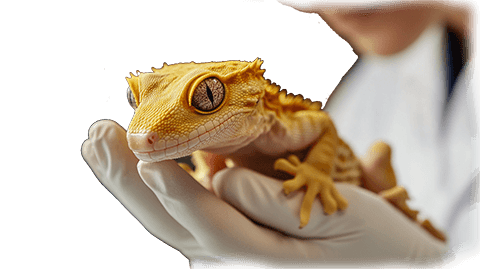Leopard Gecko Health: Essential Care Tips for a Happy, Healthy Gecko
Leopard geckos are hardy reptiles, but like any pet, they require proper care and attention to maintain their health. With the right diet, habitat, and regular monitoring, you can help your leopard gecko thrive for years to come. Below are some common health issues and tips on keeping your gecko healthy.
Common Leopard Gecko Health Issues
Even though leopard geckos are relatively low-maintenance, they can suffer from a few common health problems. Being aware of these potential issues will help you detect and treat them early.

Metabolic Bone Disease (MBD)
One of the most common health issues in leopard geckos is Metabolic Bone Disease (MBD), caused by a lack of calcium and Vitamin D3 in their diet or improper lighting in their enclosure. This condition weakens their bones and can lead to deformities if left untreated.
Signs of MBD
- Weak or soft bones
- Tremors or twitching in the limbs
- Difficulty moving or walking
- Swollen legs or jaw
Prevention and Treatment
- Provide a calcium supplement with Vitamin D3 regularly by dusting their food. (Amazon affiliate link)
- Ensure the enclosure has proper UVB lighting, which helps in Vitamin D3 synthesis.
- Feed a variety of gut-loaded insects like crickets and mealworms, which are rich in calcium. (Amazon affiliate link)
Shedding Issues (Dysecdysis)
Leopard geckos regularly shed their skin, but problems can arise if the humidity in their enclosure is too low, leading to retained skin.
Signs of Shedding Problems
- Patches of old skin stuck to the toes, tail, or eyes
- Swelling or inflammation around areas with retained skin
Prevention and Treatment
- Maintain a humidity level of 30-40% in their enclosure, but offer a moist hide to assist with shedding.
- Provide a shallow dish of water to improve humidity.
- If you notice stuck skin, you can gently bathe your gecko in lukewarm water and carefully use a soft, damp cloth to remove the excess skin.

Parasites
Leopard geckos can suffer from both external and internal parasites, especially if they are exposed to unsanitary conditions or poor-quality food.
Signs of Parasites
- Weight loss despite normal eating habits
- Diarrhea or irregular stools
- Lethargy and weakness
- Visible mites or ticks on the skin
Prevention and Treatment
- Keep their habitat clean by regularly removing uneaten food and waste.
- Provide fresh water and change it daily.
- Quarantine any new geckos before introducing them to others.
- Consult a vet if you suspect a parasitic infection, as they can prescribe medication.
Impaction
Impaction occurs when a gecko ingests substrate (such as sand or loose gravel) or food that is too large for them to digest, leading to a blockage in their digestive system.
Signs of Impaction
- Swollen abdomen
- Loss of appetite
- Inability to pass stool
- Lethargy or immobility
Prevention and Treatment
- Avoid loose substrate like sand or pebbles in their enclosure; use reptile carpet or paper towels instead.
- Feed appropriately-sized insects (no larger than the space between their eyes).
- If you suspect impaction, try a warm bath and a gentle belly massage to help them pass the blockage. If the issue persists, consult a vet.

Respiratory Infections
Leopard geckos can develop respiratory infections if their environment is too cold or too humid.
Signs of Respiratory Infections
- Wheezing or clicking sounds while breathing
- Excess mucus around the nose or mouth
- Open-mouth breathing
- Lethargy or loss of appetite
Prevention and Treatment
- Maintain the correct temperature gradient in the enclosure (warm side at 85-90°F, cool side at 75-80°F).
- Avoid overly damp conditions and ensure adequate ventilation.
- If you notice any respiratory symptoms, seek veterinary care promptly, as untreated infections can worsen quickly.

Tips for Keeping Your Leopard Gecko Healthy
Beyond preventing common health issues, here are a few tips to ensure your leopard gecko remains happy and healthy.
Proper Enclosure Setup
- Provide a temperature gradient to allow your gecko to regulate its body temperature. The warm side should be between 85-90°F, and the cool side between 75-80°F. (Amazon affiliate link)
- Use an under-tank heater instead of overhead lights for heating, as leopard geckos absorb heat through their bellies.
- Ensure the enclosure has hides on both the warm and cool sides to offer security and help with shedding. (Amazon affiliate link)
Feeding
- Feed a varied diet of gut-loaded insects like crickets, mealworms, and dubia roaches.
- Dust insects with a calcium powder and provide a calcium dish in the enclosure.
- Avoid feeding insects that are too large, which can cause impaction.
Hydration
- Leopard geckos do not require a high humidity environment, but always ensure they have access to fresh water.
- Provide a moist hide to help with shedding and hydration, particularly in dryer environments. (Amazon affiliate link)
Regular Monitoring
- Check your gecko’s weight, appetite, and stool regularly to catch any signs of illness early.
- If your gecko shows signs of abnormal behavior, don’t hesitate to consult a vet specializing in reptiles.
When to Visit the Vet
You should visit a vet if your leopard gecko shows any of the following signs:
- Lethargy or lack of appetite
- Unexplained weight loss
- Signs of impaction (swollen belly, lack of bowel movements)
- Difficulty shedding or retained skin
- Breathing problems such as wheezing or open-mouth breathing
Reading materials: “The Complete Guide to Leopard Gecko Care and Ownership: Covering Morphs, Vivariums, Substrates, Handling, Feeding, Bonding, Shedding, Tail Loss, Breeding, and Health Care” (Amazon affiliate link) by Samantha Slevens.
Affiliate Disclosure
This post may contain affiliate links, which means I earn from purchases made through links. Please see the privacy policy page for more details.





